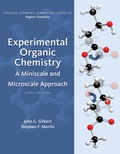
Interpretation:Thewave number for C-C stretching vibration needs to be determined, given that vibration for C=C is 1640 cm-1.The wave number for carbon -carbon triple bond needs to be determined wherein the k is appropriate multiple of carbon-carbon double bond.
Concept introduction:
There is large variance in force constant with small differences in bond length. The wavenumber is inversely proportional to square root of reduced mass. Hence, when there is increase in reduced mass, there is decrease in wave numbers.
Answer to Problem 4E
The wave number for C-C bond is 1159.6 cm-1 and stretching frequency of C-C triple bond is 2009 cm-1.
Explanation of Solution
The relation between wave number and reduced mass is depicted in equation
Where
Computing for reduced mass, the equation is
Where
Substituting
From equation (1), all the factors are constant except reduced mass and the reduced mass is inversely proportional to square root of reduced mass.
Where,
But given that
It is known that force constant for C-C triple bond is three times that of C-C single bond.
Hence, computing for C-C triple bonds.
For triple bond, the equation is
Hence, the stretching frequency of C-C triple bond is 2009cm-1.
Thus, the wave number for C-C bond is 1159.6 cm-1 and stretching frequency of C-C triple bond is 2009 cm-1.
Want to see more full solutions like this?
Chapter 8 Solutions
EBK EXPERIMENTAL ORGANIC CHEMISTRY: A M
- Show the mechanism steps to obtain the lowerenergy intermediate: *see imagearrow_forwardSoap is made by the previous reaction *see image. The main difference between one soap and another soap isthe length (number of carbons) of the carboxylic acid. However, if a soap irritates your skin, they mostlikely used too much lye.Detergents have the same chemical structure as soaps except for the functional group. Detergentshave sulfate (R-SO4H) and phosphate (R-PO4H2) functional groups. Draw the above carboxylic acidcarbon chain but as the two variants of detergents. *see imagearrow_forwardWhat are the reactions or reagents used? *see imagearrow_forward
- The two pKa values of oxalic acid are 1.25 and 3.81. Why are they not the same value? Show the protontransfer as part of your explanation. *see imagearrow_forwardасть Identify all the bonds that gauche interact with C-OMe in the most stable conformation of the above compound.arrow_forwardPredict the reactants used in the formation of the following compounds using Acid-Catalyzed dehydration reactionarrow_forward
- Can I please get help with this?arrow_forward.. Give the major organic product(s) for each of the following reactions or sequences of reactions. Show ll relevant stereochemistry [3 ONLY]. A H Br 1. NaCN 2 NaOH, H₂O, heat 3. H3O+ B. CH₂COOH 19000 1. LiAlH4 THF, heat 2 H₂O* C. CH Br 1. NaCN, acetone 2 H3O+, heat D. Br 1. Mg. ether 3. H₂O+ 2 CO₂ E. CN 1. (CH) CHMgBr, ether 2 H₂O+arrow_forwardAssign this COSY spectrumarrow_forward
 Physical ChemistryChemistryISBN:9781133958437Author:Ball, David W. (david Warren), BAER, TomasPublisher:Wadsworth Cengage Learning,
Physical ChemistryChemistryISBN:9781133958437Author:Ball, David W. (david Warren), BAER, TomasPublisher:Wadsworth Cengage Learning, Principles of Modern ChemistryChemistryISBN:9781305079113Author:David W. Oxtoby, H. Pat Gillis, Laurie J. ButlerPublisher:Cengage Learning
Principles of Modern ChemistryChemistryISBN:9781305079113Author:David W. Oxtoby, H. Pat Gillis, Laurie J. ButlerPublisher:Cengage Learning


